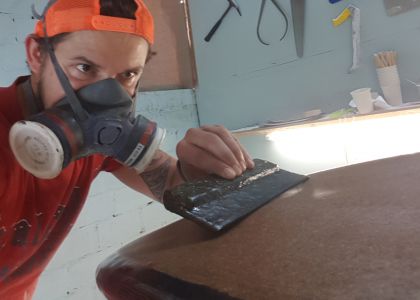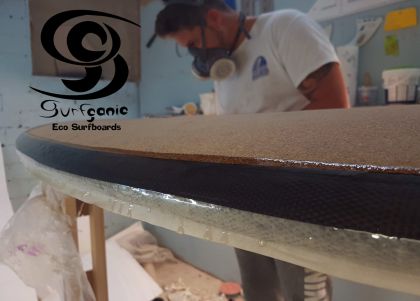Eco surfboards and sustainability in surf industry

Why environmentally friendly eco surfboards and sustainability?
Fortunately, eco surfboards are enjoying increasing popularity. By opting for an eco-friendly surfboard, you are doing our environment good and you can surf with a clear conscience!
Eco-friendliness and sustainability are two different issues, but they should go hand in hand. "Eco" is once every surfboard, which is made of recycled material. Who manufactures sustainable surfboards should not only have the profit margin in mind, but also have the appropriate attitude and environmental awareness.
The market and the materials that can be used for eco surfboards are constantly being developed and improved. Bio Epoxy, for example, was almost unavailable just a few years ago and mostly only with a low organic content. In the meantime, we can produce bio-resins of more than 50% organic content without having any quality loss of the required properties.
It is also experimenting with different core materials in which fibers from nature are integrated. To integrate recycled material into a blank is only slightly possible so far. Above a certain percentage, the blank can no longer be recycled, since its stability and machinability suffer greatly. Here, too, vigorously researched and developed.
In some cases, our composite materials have already changed in the direction of ecologically more expensive ones - instead of conventional glass fabrics, for example, Use flax, hemp, linen, basalt, just to name a few. It is also experimented with cork, wood and algae. It's an exciting time when it comes to eco surfboards, and the market is here re-positioning itself.
Sustainability is also a very important aspect in the production of eco surfboards. The materials used should be processed, degraded and developed under environmental aspects. The wood used should come from renewable organic farming, as well as cork or algarve trees. The production of resin and fiber materials are not produced anywhere in the Far East, where environmental protection is almost a foreign word, but in regional environmentally certified companies.
In the production of surfboards should be paid to the recycling of waste. The processing of surfboards with high quality materials is another important point. Of course you can also build a surfboard with cheap materials, but the question is how long will this last. The lager winner a surfboard, the less waste will be incurred. And if at some point this trash then arises, the bulk of the board should be easy to dispose of and at least be recyclable.
This is not the case with a conventionally made PU surfboard, since neither the polyester resin / glass fiber mixture nor the PU foam core can be recycled here. Thus, unfortunately, each one of us wearing a normal PU surfboard buys, in addition, these toxic and non-recyclable materials continue to land on the landfills and let the toxic waste mountains continue to grow. One more reason to opt for the next surfboard for an eco surfboard at the latest.

Production of eco surfboards
Wooden boards are made of wood, a pure natural product. It is important to note that this wood is grown sustainably and is not flipped around half the world. Pure wooden boards are beautiful to look at and can be surfed very well as fishboards or minimal bus, Old School Single Fin. However, wooden boards quickly reach their limits when it comes to surfboard performance. A high performance shortboard made of composite materials beats a wooden structure by a few lengths.
The Composite Eco Surfboards are made with blanks made of recycled materials and the resin now has a bio content of 30 - 55% without sacrificing quality. We are only at the beginning of the development and there will be a lot to do here in the next few years.
When shaping an EPS blanks, EPS attracts dust and waste, but this can be recycled and used to make new blanks.
Used eco-friendly materials in the production of eco-surfboards are for example ... recycled EPS foam cores, foam cores with fraction of natural semi-finished products such as sea algae etc., cork, wood, basalt, linen, hemp fiber fabrics, etc.
But here too caution is required! A supposed linen fabric eco surfboard for under € 600 is e.g. rather unrealistic. Often these are only thin layers of linen fabric that look good, but do not serve the durability and stableness of the board. If you want to make a surfboard made of sustainable linen fabric, which also supports the construction of a surfboard, the qm linen fabric costs about as much as a good carbon fabric.
Driving characteristics, weight and performance
The performance characteristics depend primarily on the shape of the surfboard and how well this surfboard fits. Therefore, a good advice when buying a surfboard is the nuts and bolts. The best you get with your local shaper.
Another important point is the material used. Since we do not want to compare eggs with pears, we take a standard PU board and an eco surfboard with EPS-ECO foam core and Eco Resin. Especially composite materials and epoxy resins have been developed enormously in recent years and have outpaced polyester resins by far.
Better UV resistance and significantly better mechanical properties are just a few aspects to avoid becoming too technical. Therefore, Eco surfboards are of higher quality than the old surfboards, provided that high quality products are used. You should trust your shaper.
There are usually no weight differences. However, this in turn depends on the materials used. Baslat tissue takes e.g. about 35% less resin than glass fabric and is also environmentally friendly in the production. This makes the boards noticeably easier. The weight of a surfboard is absolutely dependent on the design.
The benefits of eco surfboards
When it comes to performance, well-made eco surfboards are no worse off than conventionally made PU surfboards. The big advantage, however, is that the boards are made from environmentally friendly materials and do not pollute our environment as much as conventionally made boards.
A very important aspect when buying a surfboard should always be the sustainability of a surfboard. Good workmanship and high-quality materials make a surfboard live much longer and reduce the garbage on broken discarded surfboards in the long term enormously.
Our conclusion:
So why still buy and surf non-recyclable PU surfboards when the latest generation of eco surfboards is on the same level as the normal standard surfboards? No, but much more even provide significant benefits in terms of longevity, flex and thing-resistance of the surfboard. There is really no good reason anymore to buy a conventional poisonous polluting PU surfboard!
The best way to find your perfect Eco Surfboard is to contact a local Shaper. A board from the Shaper is not necessarily more expensive than a surfboard off the shelf and you also have a contact who knows exactly what he is talking about. There you get exactly the board that suits you and is perfectly tailored to your needs.

Where can you get good eco surfboards?
Unfortunately, there are only a handful of surfboard manufacturers and shapers who have specialized exclusively in the production of eco surfboards and have developed their own environmentally friendly manufacturing process using environmentally friendly and sustainable materials. A pair of them can be found e.g. along the European Atlantic coast in France, northern Spain and meanwhile also in Portugal.
But even in Germany there is a shaper that already intensively deals with the topic of eco surfboards and creates great unique surfboards made of alternative environmentally friendly materials. The Steve from Surfganic Surfboards has tackled this important issue and created a unique eco surfboard range with great models and shapes.
Here is really something for every surfer here. For example, the High Performance Shortboards are 30% lighter than traditional high performance surfboards, and are also much more durable and durable. Or the cork basalt construction developed by him. Here you do not need an environmentally harmful Surfwax more!
The natural grip of the cork deck and the specially developed processing method leave nothing to be desired even during radical maneuvers. The damping properties of the cork and the sophisticated construction give these eco boards an enormous flex.
Naturally, the Surfganic Eco Surfboards are hand-shaped and manufactured in Germany, which also means that the transport routes to the customer can be kept to a minimum. In addition, attention is paid to a local and environmentally friendly supply of the products. The blanks are not shipped halfway around the world but are made in close proximity and even contain 20% recycled material.
In the Surfganic online shop, you can not only buy the Surfganic Eco Surfboards, but also a variety of other environmentally friendly surfing products. So you find there, for example eco-friendly wetsuits made of recycled neoprene and cotton (for the inner warm lining) and meanwhile wetsuits made of natural pren, which is made of natural materials such as Yulex.
Surfganic also offers its own eco-friendly surf products, such as Eco Tailpads and Eco Surfleashes etc. The Surfgan Surfganic product range is constantly expanding and looking for new greener methods.?


